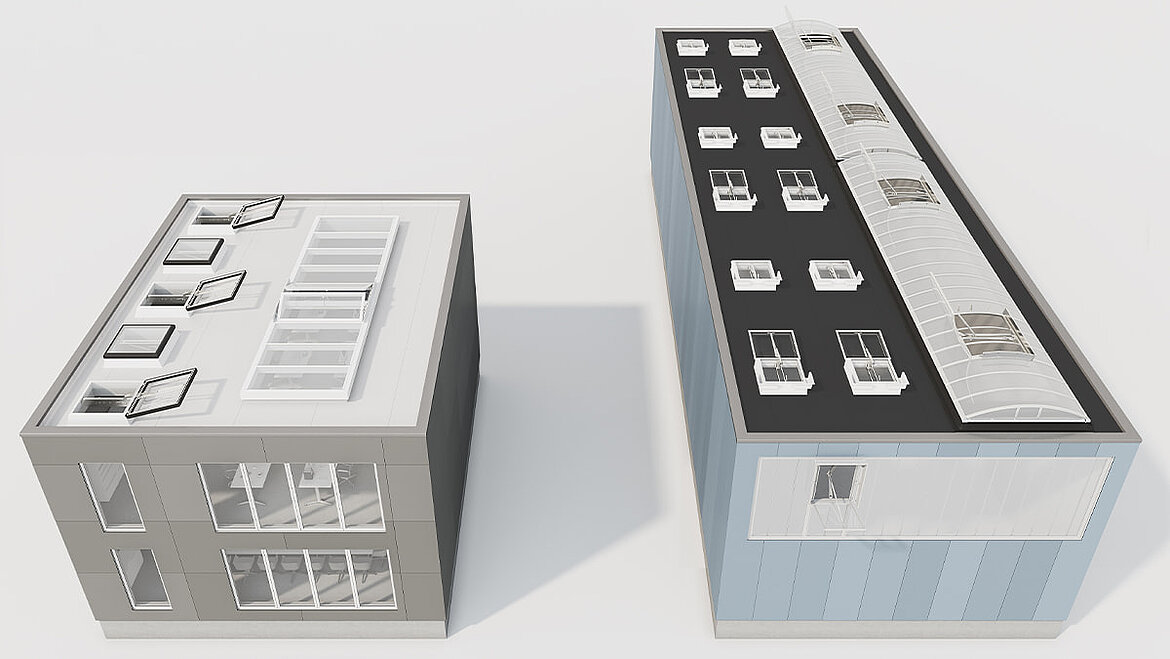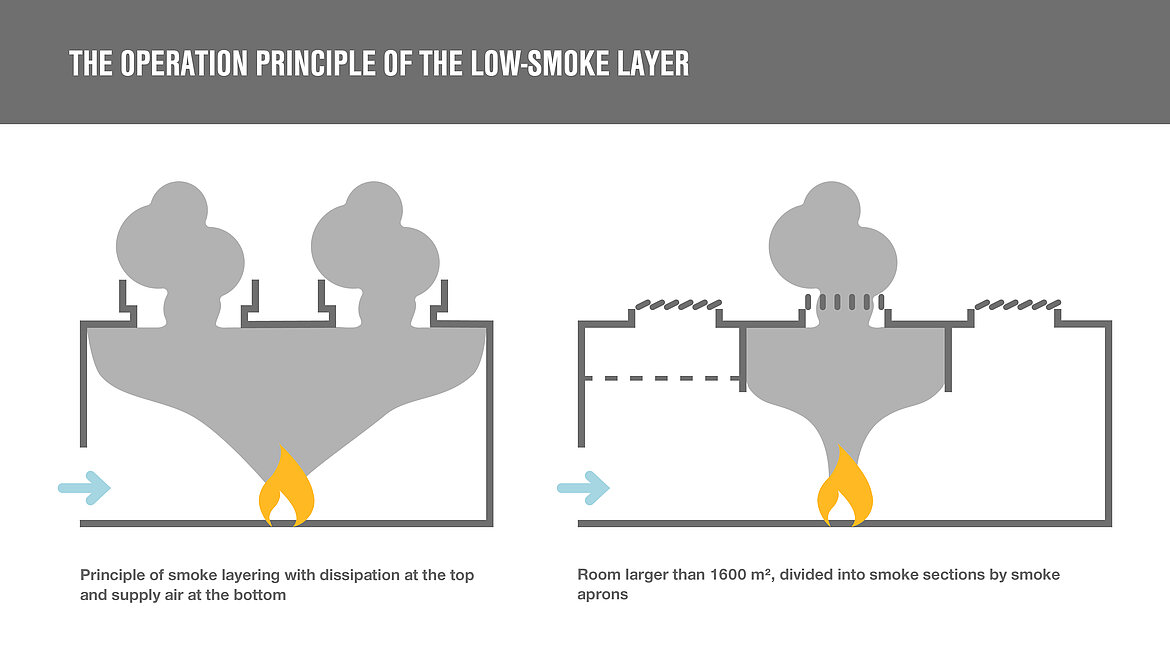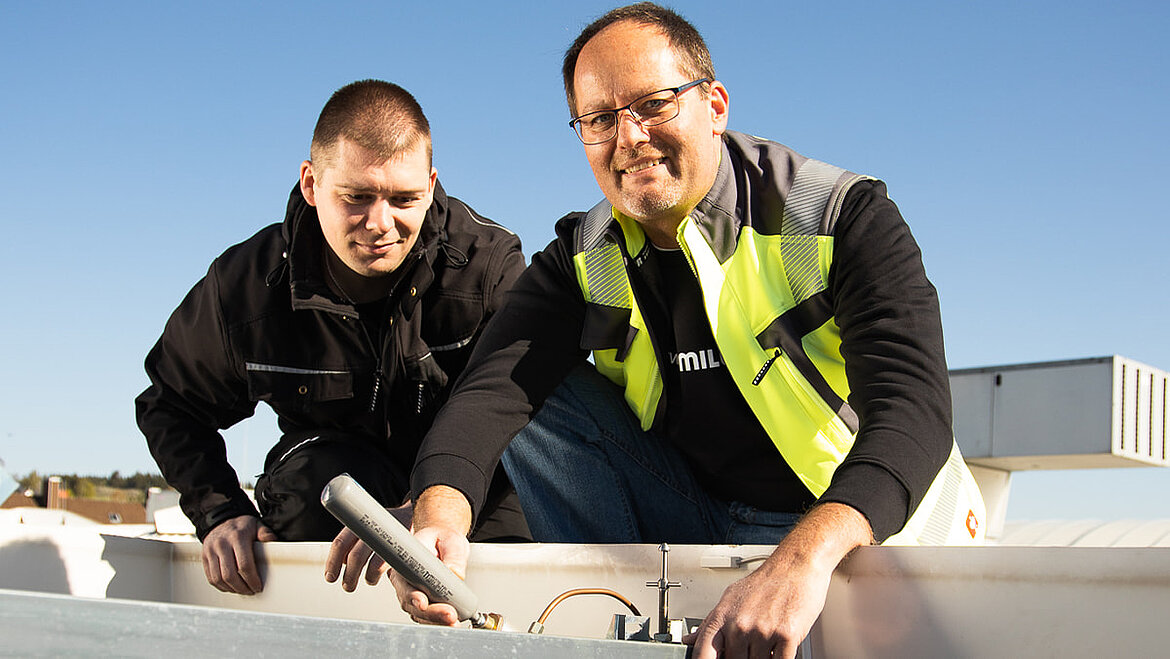Smoke and heat extraction systems save lives
Smoke and heat exhaust ventilation systems (SHEVS) are an important component of preventive fire protection. They serve to protect both human life and property. If SHEVS are planned correctly, they can limit damage from the maximum extent possible or even prevent it. Depending on the type of building, various legal principles, regulations and recommendations must be considered when dimensioning. Because only if SHEVS are selected properly for the type of building, smoke and heat ventilation systems will direct the dangerous fire smoke out of the building and save lives.
What exactly is a SHEV?
Smoke and heat exhaust ventilation systems save lives. In doing so, however, smoke and heat exhaust ventilation systems by no means prevent a fire. But in case of fire, they do have a considerable influence on limiting the damage and protecting the property. How does it work? Explained effortlessly, a smoke and heat exhaust system consists of individual smoke and heat exhaust units (SHEVs). SHEVS can be roof lights, glass skylights or opening vents in glass roofs and continuous roof lights - in short: openings in the roof surface that are integrated into skylight systems.
These open automatically or manually in case of fire, forming exhaust openings to release smoke and fire gases through the roof. In addition, a smoke and heat ventilation system can include supply air openings in the lower wall area, fire detection elements, activation or release devices, opening units, power supply lines and smoke aprons in case of larger rooms. What exactly is behind a smoke apron is explained later in this article in connection with the low-smoke layer.
SHEVS must be dimensioned in a way that all smoke and fire gases are removed as quickly as possible and cannot completely fill the room in case of fire. The primary goal is to always create a smoke-free zone on the floor. How the SHEV system must be designed and how the individual smoke exhaust units must be arranged depends on the size, type and use of the building.
How is a SHEV dimensioned?
The calculation of a SHEV is based on the Aa area (formerly Aw-). The Aa area of a SHEV (window, rooflight, skylight) is the area that may be considered aerodynamically in the fully open state - i.e. the aerodynamically effective opening area (Aa). The Aa area is defined both for a unit and for the entire system. The total effective opening area of the complete SHEV then accordingly is the sum of the effective opening areas of all the individual smoke extraction units. Smoke and heat exhaust ventilation systems can be arranged on flat roofs in the form of roof lights or continuous roof lights, glass skylights or glass roofs, or as side windows located directly below the ceiling.
How SHEVS works
The operating principle of a smoke and heat exhaust system is based on the physical principle that warm air rises. This natural smoke extraction is caused by the thermal lift that is generated by openings in the roof or façade. The openings or heat exhaust units consequently offer the possibility of keeping buildings smoke-free, at least in the lower area, during the event of a fire. This way, lives can be saved and at the same time the building structure can be thermally relieved through targeted heat dissipation.
Smoke control focuses on personal protection. The smoke-free layer created by SHEVS ensure that people in the building have sufficient visibility and enough oxygen to allow them to escape. Heat dissipation, on the other hand, is primarily about building preservation and firefighter safety during extinguishing. In both cases, natural or mechanical smoke extraction systems therefore support the following tasks in case of fire:
- The self-rescue and external rescue of people, since people can see and breathe.
- The inside attack of the fire department, as the fire department can see thanks to SHEVS, orientate themselves quickly, rescue and fight the fire.
- The protection of property, since a reduction in heat exposure and smoke spread protects buildings and fittings.
- The protection against operational failures due to far less smoke damage to buildings and systems and correspondingly faster fire damage restoration.
Escape and rescue through low-smoke layer
A SHEV is designed for the initial phase of a fire. This is the first 20 to 30 minutes until the arrival of the fire department and its first measures for rescuing people and extinguishing the fire. The smoke extraction system is planned in such a way that the smoke is layered in the room. This means that the upper area of the hall is smoked, while a layer of at least 2.50 m high above the floor remains, in which free visibility and breathable air is ensured. The layer can also be dimensioned higher, e.g. to protect goods or production facilities.
For this purpose, as much smoke is extracted from the upper third of the room as is released by the fire and in the lower third the same amount of fresh air is supplied from outside. Small rooms of less than 200 m² are usually designed without smoke extraction, as the escape and fire-fighting routes are shorter there. Rooms larger than 1600 m² are divided into smoke sections through smoke aprons, each with a maximum of 1600 m². That way, the smoke can only spread within the section under the ceiling, does not cool down too much and remains hot enough to escape upwards through the openings. In this case, only the units within the affected section are opened, namely all together from a central release station.
Not all SHEVS are the same
The generic term SHEV stands for all types of smoke and heat exhaust ventilation systems. It includes various system technologies that differ in their mode of operation and function. The following SHEVS are distinguished:
- Natural smoke exhaust system (NRA)
- Mechanical smoke exhaust system (MRA)
- Smoke differential pressure systems or smoke protection pressure systems (RDA)
- Garage smoke extraction systems
- Elevator shaft smoke extraction
- Stairwell smoke extraction systems
- Heat extractors (WA)
A variety of abbreviations is used in smoke protection, all of which have different meanings. SHEVS, NRA, NRWG or MRA - as similar as the abbreviations sound, they are actually extremely diverse. This makes it all the more important to know exactly which abbreviation stands for what. We have listed and explained the most important terms for you:
SHEVS
The generic term SHEVS refers to a complete smoke and heat ventilation system consisting of the individual smoke and heat ventilation devices (SHEVS), the triggering and operating elements, the power supply, the ducts, the air supply and additional smoke aprons in the case of larger rooms.
Natural smoke exhaust system
Natural smoke exhaust systems provide open areas in the upper third of the room through which the smoke is drawn upwards as a result of thermal lift. It only works when the smoke is hot, but then it is significantly more effective and less expensive than mechanical smoke exhaust systems. Naturally natural smoke exhaust systems also function as heat vents, while heat vents, conversely, are not necessarily suitable for use as natural smoke exhaust system, since they often do not release their surfaces until the fire is advanced and temperatures are high. The natural smoke exhaust system is characterized by the fact that its function is based on the thermal lift principle, like for example, with roof lights or louvres. A specialist in natural smoke exhaust system devices is LAMILUX, whose skylight systems are used as natural smoke exhaust systems and heat vents.
NSHEV
NSHEV stands for natural smoke and heat exhaust ventilator and refers to the single product that creates an opening. It is used in the building's outer shell, like for example in roof lights or windows in the wall.
Mechanical smoke exhaust system
The term "mechanical smoke exhaust system" implies that the functions of this SHEVS are performed by a motor drive, for example by fans. In case of a mechanical smoke ventilation system, the energy supply to the fans must therefore be ensured during the entire operation, whereas NRA only require initial energy to open the surfaces. Applications of mechanical smoke exhaust systems are mainly lower floors from which smoke cannot be dissipated upwards through natural smoke exhaust systems. In contrast to them, mechanical smoke exhaust systems also dissipate cold smoke, but their mass flow rate is reduced as the smoke temperature increases.
Smoke protection pressure systems
Smoke differential pressure systems or smoke protection pressure systems do not dissipate smoke but prevent smoke from entering escape routes such as corridors and safety stairwells. Put simply, they use fans, ventilation openings and smoke exhaust units to ensure that there is a constant slight positive pressure in the room to be protected, so that smoke from a corridor cannot enter the stairwell, even if the doors in between are used by people trying to escape. In short, in case of fire, a controlled build-up of positive pressure keeps the room to be protected, such as escape routes or stairwells, free from smoke. However, under no circumstances that much pressure should be created that the doors to the stairwell can no longer be opened.
SHEV
A smoke and heat exhaust ventilator (SHEV) is the element, including the opening systems, which releases the opening in the roof or in the wall for the dissipation of smoke to the outside. These can be: roof lights, glass skylights, continuous roof lights, glass roofs as well as louvre or double opening vents.
Heat exhaust
The heat exhaust is a wall or roof surface which automatically releases an opening at a certain temperature, for example by melting thermoplastic rooflight elements. The dangerous fire heat and toxic fire smoke can then escape through this opening. The open areas, usually in the upper third of the room, dissipate accumulated heat. The principle is similar to that of a natural smoke exhaust system. The surfaces usually open much later though because they have to melt away first. Therefore, a heat exhaust vent is not suitable as a natural smoke exhaust system at the same time.
Garage smoke extraction
A garage smoke extraction system is an individually planned and designed smoke displacement and smoke extraction system. It supports self-rescue and external rescue, firefighting and property protection. The selection of a smoke extraction system for garages depends on the area and height of the garage space and whether the garage is above or below ground. In the case of underground garages, layering of the smoke is not possible due to the low room height. In this case, it is limited to using thrust fans to force the smoke into predetermined areas from which it is extracted. This does not protect the entire area, but at least a large part of it.
Elevator shaft smoke extraction
Elevator shaft smoke extraction by SHEV systems fulfils two legal requirements: smoke extraction in case of fire and ventilation in case of need. For this purpose, smoke detectors are installed in the elevator shaft and opening vents at the upper end. These are triggered in case of fire and guide the smoke upwards out of the shaft head. The main aim here is to prevent smoke from passing from one floor to another via the elevator shaft.
Stairwell smoke extraction
In stairwells, unlike in halls, smoke layering is not possible to keep the escape and fire-fighting route smoke-free. This is because the smoke rising upward naturally flows through the entire stairwell from the smoke source to the discharge opening. For this reason, fire load-free stairwells and self-closing smoke-tight doors to the corridors are required in corresponding buildings. In order to enable the fire, department to purge the stairwell of smoke after evacuation, stairwell smoke extraction is required in buildings of 13 meters or more or five stories or more and for interior stairwells, depending on the state building code. Devices such as the SHEV stairwell set from LAMILUX are ideally suited for this purpose. This is a ventable rooflight or a glass skylight with two SHEV control switches. The rooflight is not a SHEV device in the sense that a low-smoke layer is created, i.e. it is not an NSHEV according to EN 12101-2. For flushing, the fire department then uses mobile fans at the entrance door.
SHEVS - regulations and guidelines
Smoke and heat exhaust ventilation systems are indispensable for a responsible fire protection strategy. Both for the protection of human life and for the preservation of property and building values, damage prevention and damage limitation are national and economic regulations. Legal principles and technical rules specify what needs to be considered in planning, calculation and execution. For Germany, the regulations are as follows:
State Building Code
The state building code initially sets out basic requirements, which are then specified in further regulations. For example, Section 14 of the MBO states that "Structural installations must be arranged, erected, altered and maintained in such a way that the development of fire and the spread of fire and smoke (fire spread) are prevented and, in the event of a fire, the rescue of people and animals and effective extinguishing work are possible."
The respective state building code of the federal state concerned also requires smoke outlets for stairwells in all buildings above a certain height. These include buildings in which people may be present on one or more floors at a height of more than seven meters and places of assembly. An example of this is the stairwells of special buildings where there are large numbers of people who are not familiar with the location. These can be large cultural facilities or sales outlets, for example. There, SHEV systems are mandatory and release mechanisms must be placed on each floor.
DIN 18 232
DIN 18 232 focuses on smoke and heat extraction to create low-smoke layers. It regulates the dimensioning, gives instructions for proper installation, specifies test procedures and represents the recognized state of the type.
VdS - Guideline 2098
VdS Guideline 2098 includes further recommendations for the planning and installation of smoke and heat exhaust ventilation systems and specifies additional requirements from an insurance perspective. It requires smoke and heat exhaust ventilation systems for all single-story commercial buildings and for multi-story buildings where the ceiling is also the roof structure. This guideline is particularly important. If it is not complied with, the SHEVS will not be considered in the discounting of the fire insurance premium.
Special building regulations
For buildings of a certain type or use, there are other regulations that often also contain rules on smoke extraction. These include, among others, the Industrial Building Directive, the Ordinance on Places of Assembly and the Ordinance on Places of Sale, whose scope of application is implicit in the name in each case.
Safety through maintenance
Smoke and heat exhaust systems are sensitive and safety-relevant components. For this reason, they may only be planned, installed and maintained by recognized and experienced specialist companies. Specialists in the field of smoke protection will ensure that the smoke and heat exhaust system is correctly designed and properly installed. Regular inspection and maintenance also play a major role. After all, maintenance ensures the functionality of the system.
Every six months or once a year, a VdS-approved specialist company must inspect, maintain and, if necessary, repair the system so that it is reliably and safely ready for use in case of a fire. LAMILUX, for example is a VdS-approved specialist for the safe installation and maintenance of SHEV systems. As a manufacturer of skylight systems as well as SHEV systems and their control technology, the company has all the expertise to maintain and repair the systems for natural smoke and heat extraction and their pneumatic or electrical control technology integrated in the most diverse variants of skylight systems.






